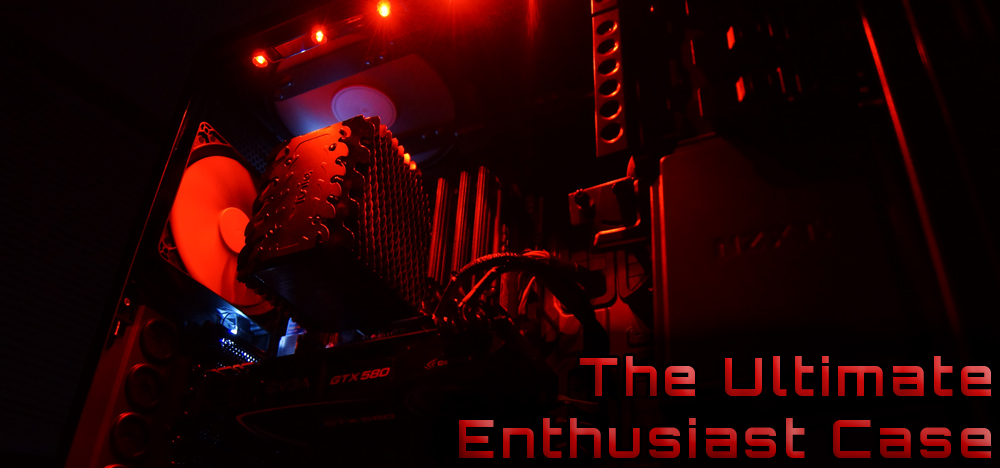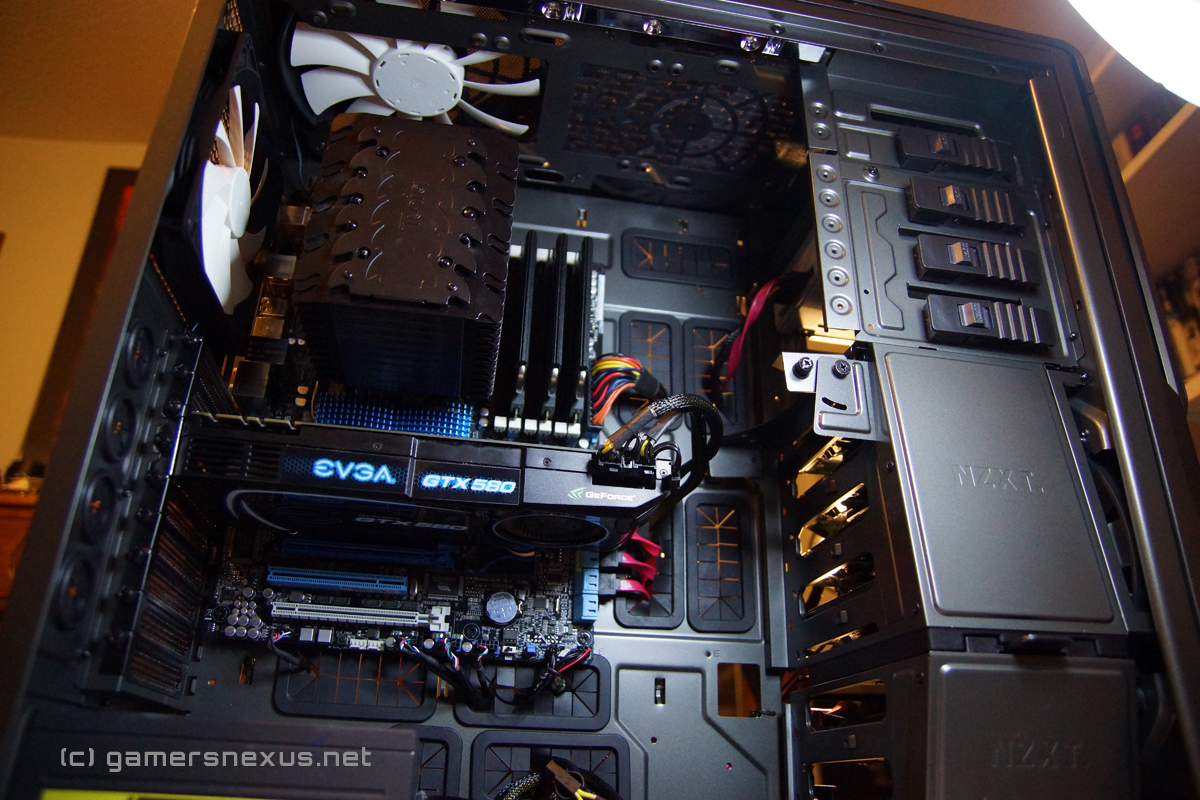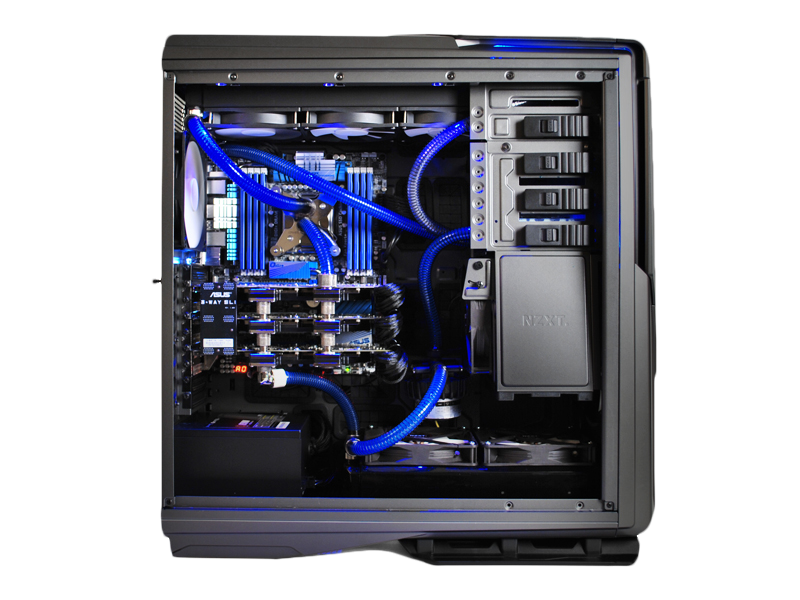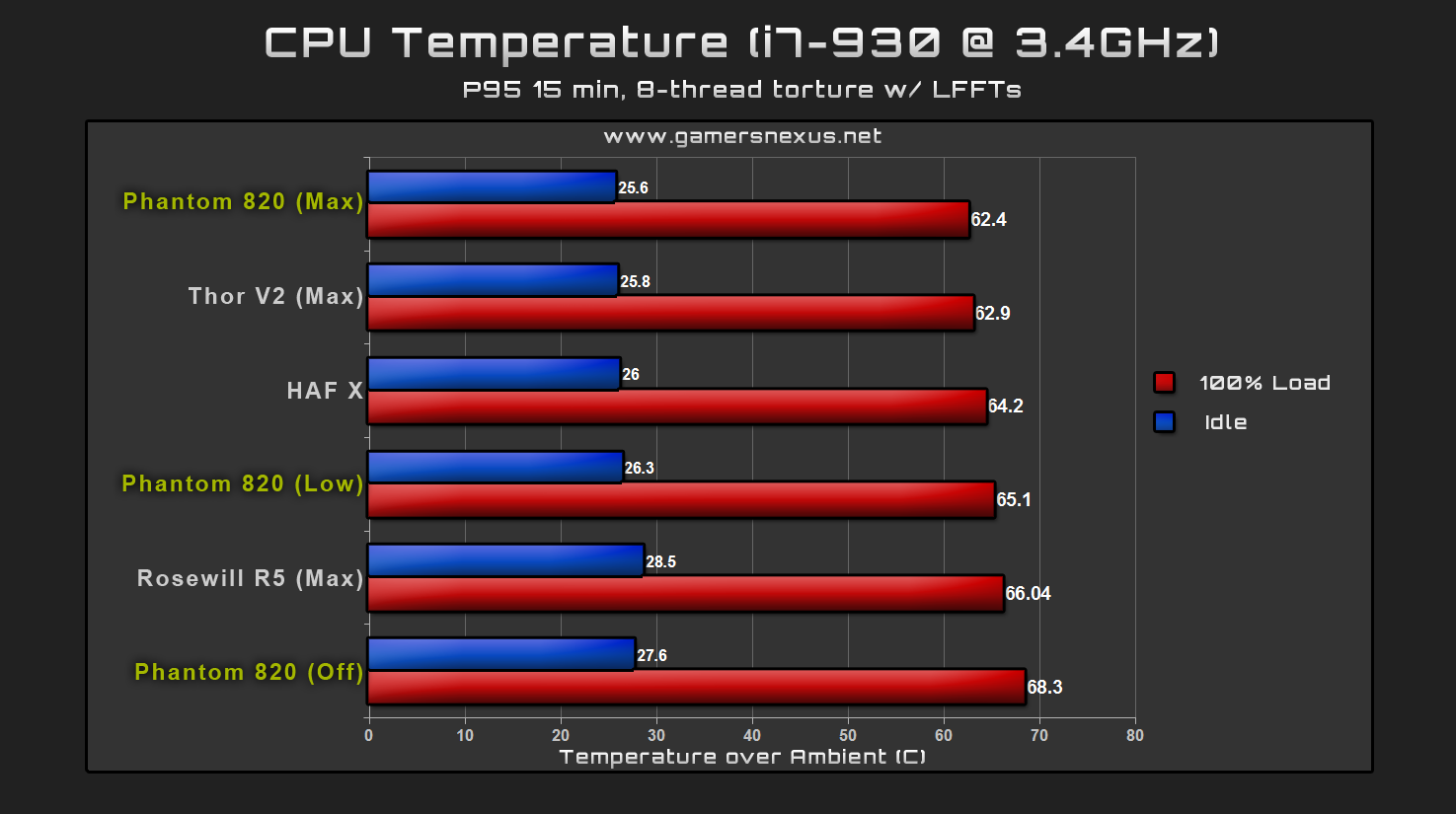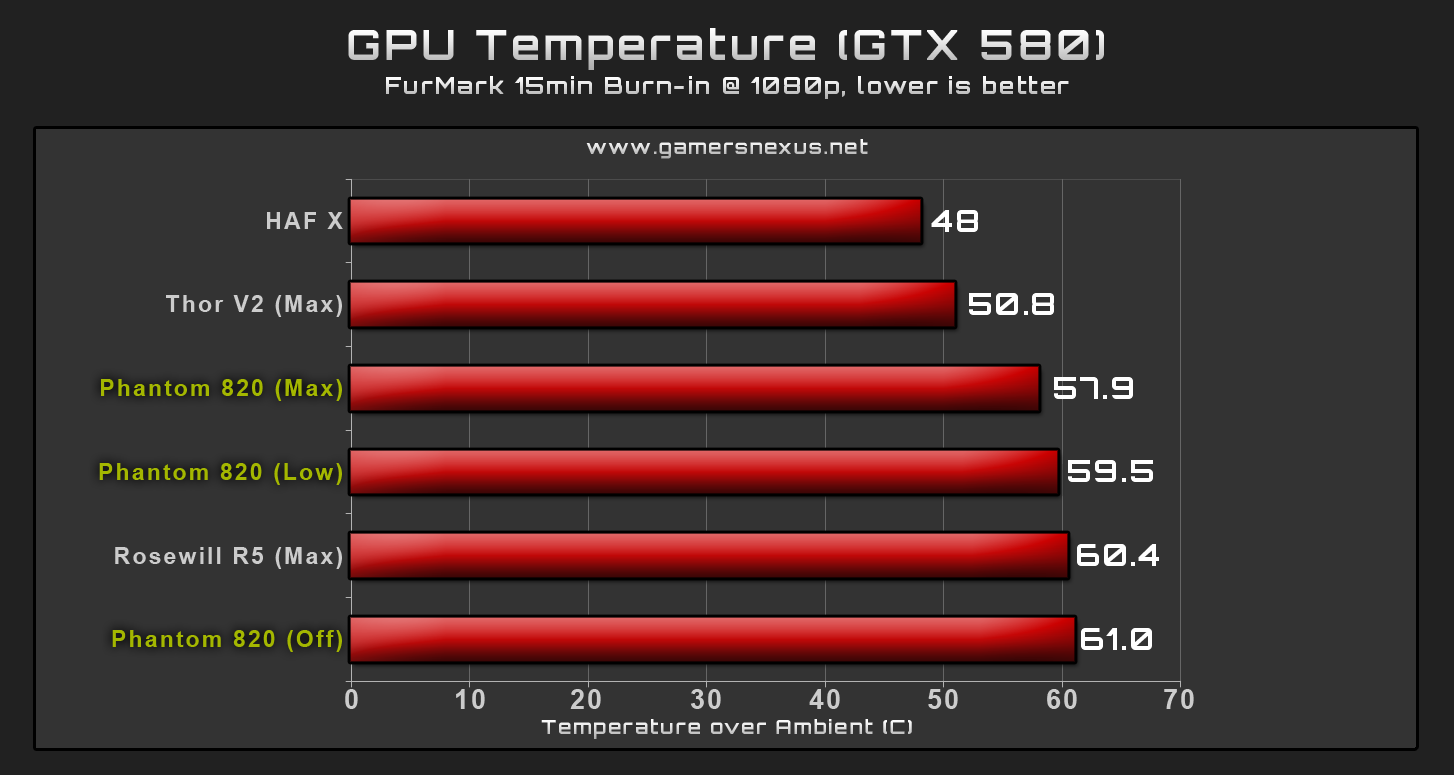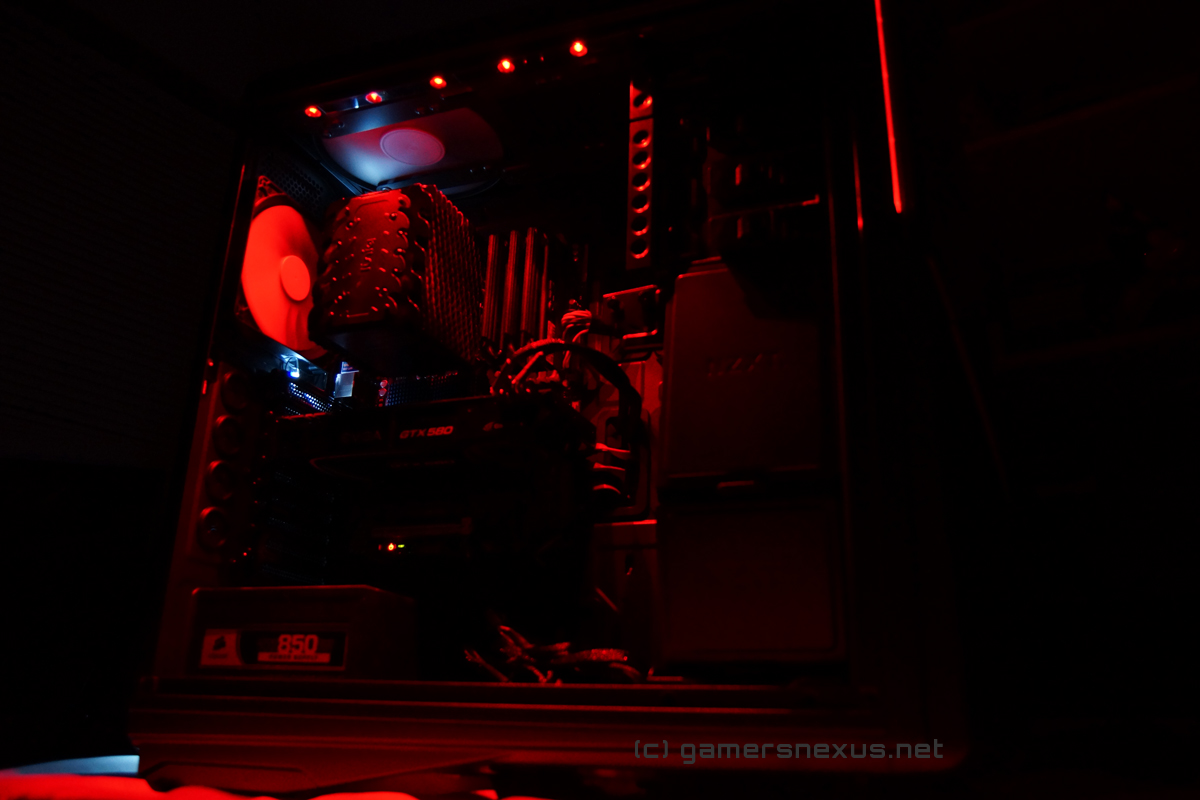NZXT's cases have secured a reputation for their knifelike designs: the cases are sharp and emit an almost preternatural aura, using jagged, cutting elements in unique combination with rounded and beveled-out features. And in that fashion, they're almost very Alienware-like in aesthetic -- astral and radiant.
The company's offerings range from dirt cheap to otherworldly, with build quality scaling immoderately within that spectrum. We had the chance to review the crème-de-la-crème of NZXT's cases recently (including a video review, below): The behemoth Phantom 820, currently marketed at $250 for high-end or enthusiast system builders.
We were impressed.
NZXT Phantom 820 Case Specs Review
| Case Type | Full Tower |
| Material | Plastic/Steel |
| Dimensions | 235mm (W) x 650mm (H) x 612mm (D) 32 lbs. |
| Cooling System (Included) | 1x200mm Front (Intake) 1x200mm Top (Exhaust) 1x200mm Side (Intake) 1x140mm Rear (Exhaust) |
| Cooling System (Extras) | Room for up to 9 total fans, including: 1x140mm interior drive fan 2x140mm bottom fan 1x200mm top fan Plenty more, as seen here. |
| Liquid Cooling | Room for three fans in push-pull: - 90mm internal top space. - Top 280/360mm compatibility. - Bottom 240/280mm compatibility. |
| Front Panel | 4xUSB2 2xUSB3 2xAudio 3.5mm 4-channel fan controller HUE LED Controller / Power state buttons |
| Expansion Slots | 9x Expansion slots 4x5.25" Drive Bays 6x3.5" Internal drive bays w/ 2.5" compatibility. |
| Form Factor | E-ATX, XL-ATX, ATX, Micro-ATX, Mini-ITX (WHY?!) |
| MSRP | $250 |
NZXT Phantom 820 Special Features
- Integrated HUE LED lighting system.
- Rear I/O light.
- SD Card reader.
- 4-channel, 15W fan controller; offers a wide range of fan speed settings (from off to high).
- Room for high-end liquid cooling solutions, including three fans for push-pull. 90mm of top space, top 280/360mm and bottom 240/280mm radiator support.
- Pivotal interior 120/140mm fan mount.
- Removable bottom drive cage.
- Massive side panel clearance for cabling (36mm/1.4" clearance).
- Plenty of dust filters.
- 10+ Cable management holes.
That's a lot of features. Some of these options you may have never heard of before -- like the HUE lighting system -- so let's dive into each of these and break-down whether or not they are relevant to your uses.
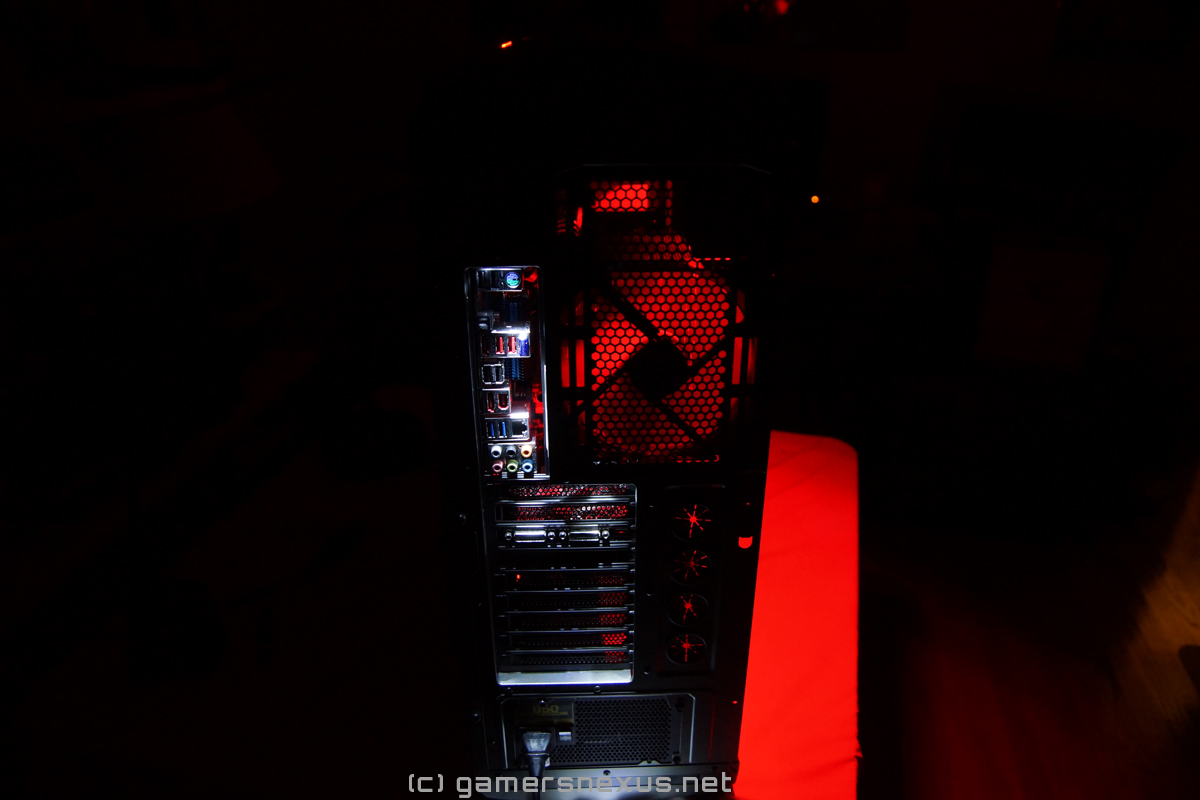 The backlit IO panel can be toggled via front-panel buttons.
The backlit IO panel can be toggled via front-panel buttons.
The HUE system that is integrated with the Phantom 820 is sort of a HUE-lite. It's not exactly the same as the full HUE package that is offered, but more than enough to offer fantastic spotlighting capabilities where they count. An LED strip lines the top-left wall of the case (the ceiling, as it were), where it casts light down upon the acrylic side panel and then is accentuated by the angles in the acrylic. Most notably, the HUE system is capable of producing almost any color you'd care to create, as it has dozens of vibrance & depth levels for each major color. I attempted to count the individual colors offered and came up with somewhere in the range of 70-or-so variations (some of the differences are minor, so I may be off by +/- 15 colors). Regardless, it's quite a lot of color options.
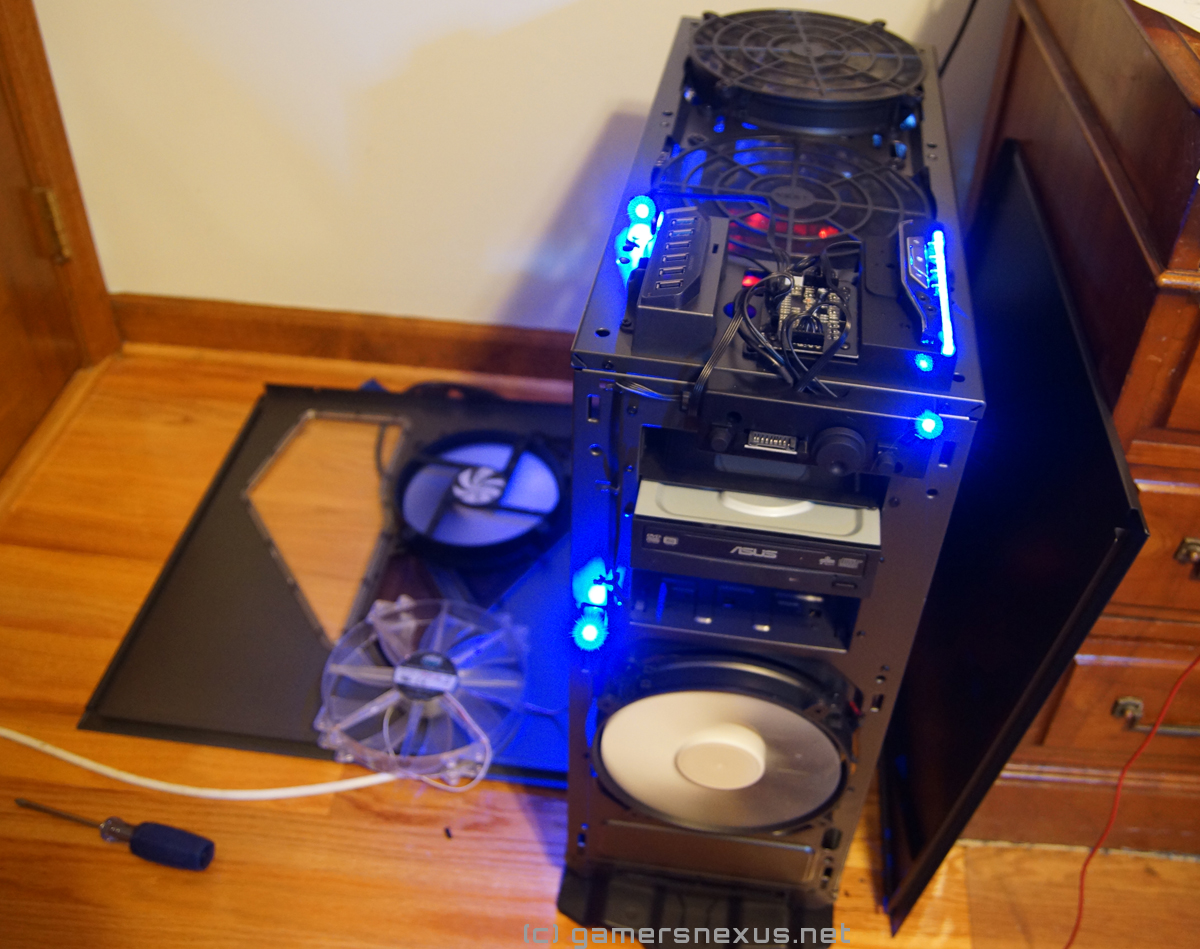 The shell, completely stripped of panels.
The shell, completely stripped of panels.
LED colors can be changed by a radial dial (spin it until you're happy); two other buttons flank the color dial, one which controls the IO panel backlight, and one that controls the two color zones of the case (front only, internal only, both active, or off). The IO panel light is a nice touch for nighttime cable swapping.
Aside from all the lighting options, we also have an SD card reader, audio ports, and 6xUSB ports (2xUSB3; 4xUSB2) on the top and front of the case. I have a bone to pick with the SD card reader, though: The hinging front-panel cannot be closed when an SD card is inserted into the reader, despite a small (but not deep enough) cut-out being present in the panel. There's clearly an attempt to accommodate SD cards and still allow the case to close, but it doesn't quite pan-out. It's a shame, because I can't trust myself to not kick the hinged door or SD card when walking by, so I've ended up using a USB dongle instead. Were the SD card reader positioned slightly lower, if the panel had a deeper cut-out, or if the reader were just positioned deeper in the chassis, I think it'd fit much better. Leaving it exposed is to dangerous, though, as one miscalculated step will take the door off immediately.
And a small bone it was.
Moving on, the case also mentions its 4-channel fan-speed controller. Using hardware buttons on the top-right of the case, we're able to manipulate fans through a sizable range of RPMs, from off to full-blast. We tested the full speed, low speed, and off settings in our performance thermal testing (below). A series of dust filters complement the fans in the bottom-front (which extends centrally) and back-rear positions; there are also filters within the interior that guard the fans from further dust infiltration. I do wish that the rear dust filter would eject toward the left rather than back, though -- it's more accessible that way and does not require moving a massive rig!
Finally, one of the biggest offerings on the Phantom 820 is its cable management features, but we'll cover that in the appropriate, dedicated section.
All of these features do end up costing you $250, but the total package is certainly nothing to scoff at. If you're feeling overwhelmed by all of this, check out our "how to pick a gaming case" guide!
Phantom 820 Build Quality & Construction
The overall quality of material for the Phantom 820 feels solid -- the exterior is primarily composed of a hard plastic and steel that doesn't feel like it's going to break. I took the entire case apart, all the way down to the chassis, and was pretty happy with the way they routed the wires: Unlike some cases I've worked with (the HAF X as an example), the 820 anchors all of its front-panel and fan connectors to the chassis frame itself, so every panel (front, sides, top) can be completely removed without fear of breaking glue joints for cabling. Unfortunately, as I worked with the case throughout the review process, I found the plastic to be scratched with unbelievable ease; the paint scratched off very easily with minor abrasion, though I was able to buff most of it out with buffing compound. Don't get me wrong -- the case was handled with utmost care, but perhaps it was just that the "gunmetal / military gray" color we received is more noticeable (or wears off more readily) than matte black. At the end of the day, it's not a huge deal. Just be extra careful with it if cosmetic blemishes matter to you.
Quality on the interior mirrors the exterior: High-contrast black/white fans are equipped to the top, rear, side, and front (200mm at 800RPM for the front and top; 140mm at 1100RPM for the rear and side), thumbscrews and tool-less mounting runs rampant, and well-positioned cable routing holes saturate the massive amounts of empty space. To be fair, though, it's kind of hard not to be (in good hands) "well-positioned" when the entire mounting wall is riddled with rubber-screened routing holes, which made for the easiest cable management I've ever had the fortune to encounter.
The tool-less mounting bracket for the internal drive bays is accessed from the right-side of the case, something I'm still not used to, but you'll need to remove that panel for proper cable management anyway. On the same note, the drive cages felt exceedingly flimsy and were a bit more difficult to re-align with their mount-points than I felt comfortable with. This issue is something we've encountered consistently with several cases, but I have been most satisfied with Corsair's mounting bracket design in similarly high-end cases. One stipulation I had was on the notion of a lighter overall package; it almost felt like NZXT was trying to find places they could cut down on a few ounces (seeing as the case is already intriguingly unwieldy and heavy when filled). But at the same time, if NZXT's planning to release an ultra high-end product, they shouldn't see weight as a hindrance; users at this niche pricing level will pay for more as long as it's best in class.
Further on the front of quality control, the tool-less mounting points for external drive bays have come loose on me several times when working elsewhere in the case, even if not working near the optical drives. At least in our sample, the tool-less clips felt loose and were tricky to properly mount the drive. A simple thumbscrew would have been faster and provided more security than the plasticky mounting points.
I want to underscore the fact that, when matched up against the rest of the case's high-quality standards, these issues feel negligible. I think the next section will help illustrate why; of course, at $250, it's important to note all of these minor items so that, with any luck, they'll be improved upon for the next iteration.
Phantom 820 Cable Management
Cable management is definitely the new "thing." Apparently adding an ever-increasing amount of blue LED-enabled fans got old, and at some point down the line, case manufacturers decided it was in their best interest to invest in a more immediately usable feature. Cable management was that feature. If you're new to cable management, we wrote a beginners guide over here.
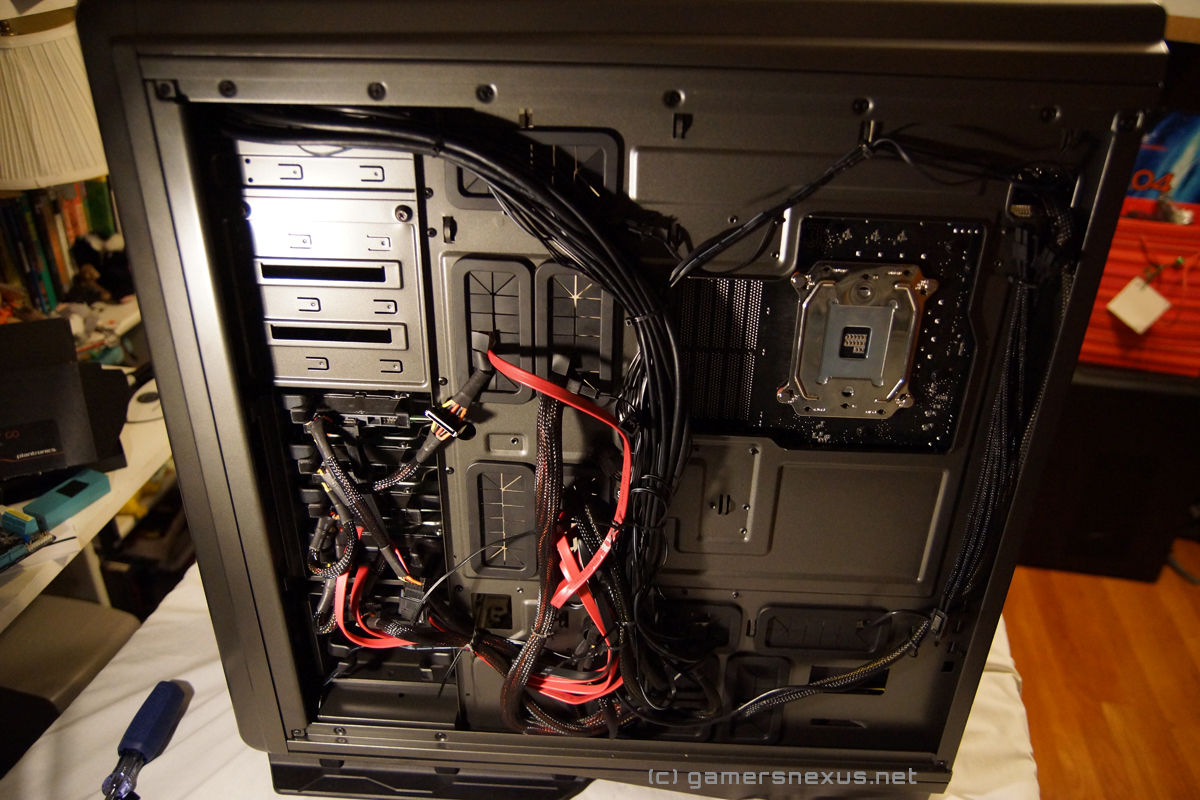 Yes, that mass of cables will actually fit with the panel on. Unbelievable.
Yes, that mass of cables will actually fit with the panel on. Unbelievable.
The Phantom 820 almost feels like it went overboard with the cable routing options. Almost. I ended up using every hole to hide some cable or another, so at the end of the day, it worked out to be one of the quickest-to-manage cases I've ever built up. It has -- let me count them again -- ten grommet-encased routing holes, two cleanly-cut square routing paths for certain cables (like 8pin power), and an abundance of anchor points for cable ties. On top of that, many of the front-panel connectors ship pre-tied (although I had to re-route them to a lower hole), the fans are pre-connected to the HUE controller, and NZXT hides a secret EPS12V extender (one of the nice ones - the type sporting their Premium Cable Kit housing). This is where the pampering comes in. Remember all those issues with mounting drives? They were quickly minimized by the amount of work reduced by these pre-managed features.
There's not one place in the sidewall that you'll say, "I wish the routing hole were here instead of there" (something I found myself saying constantly with NZXT's LEXA S); no, you won't say that at all -- and that's because they're everywhere. There are very few spots where you cant hide a cable. Better still, the way the sidepanel is designed allows for easy hiding of clustered/unused cables from non-modular PSUs (because the acrylic window is focused on the GPU / CPU view), so you won't have an ugly view from the outside. Granted, I doubt many system builders who drop $250 on this case will be using a non-modular PSU, but we use them for every case review so we can better analyze the management options.
Continue to the next page for benchmarking stats and performance / thermal testing!
Phantom 820 Performance & Benchmark
It seems that "X slots for optional fans" has become a sort-of marketing trend of late, with every case manufacturer finding a way to offer 7, 8, 9, 10 extra fan bays on their cases. We recently built a smoke chamber (videos impending, it needs a few final tweaks) to test case airflow when filled with the stock fans or maxed out, and in general - almost irrespective of intake/exhaust configuration - vortexes and dead-air spaces form throughout cases with maximized fan occupation (depending largely upon case design).
While surveying the below graphs, keep in mind that we found that adding an additional 140mm fan to the bottom significantly impacted the video card, dropping its temperature an extra 7C on average when under load. That's significant enough to put the Phantom 820 up there with the HAF X. We also noticed, however, that installing an extra 200mm fan in the top as exhaust increased CPU temperature by an average of 3C; I believe this is a result of a conflicting air current that is forming, as the CPU intake is facing the front of the case and will be fighting the additional top fan for cool air. With this in mind, if you're considering adding extra fans, just add a 140mm bottom-mounting fan (assuming you have a modular PSU, otherwise there's no room).
Testing Methodology
- CPU: Intel Core i7-930 Nehalem, overclocked at 3.4GHz.
- CPU Cooler: Tuniq Tower 120 Extreme.
- GPU: GTX 580
- Motherboard: ASUS P6X58D-E Pro
- RAM: OCZ 12GB DDR3 Triple-Channel memory
- Storage: 2x5900RPM HDDs; 2x7200RPM HDDs; 1xKingston HyperX SSD.
- PSU: Corsair 850W PSU.
All of our testing is conducted in a temperature-controlled environment. Ambient is between 21C and 22C for case airflow tests. The graphs measure temperature in Delta over Ambient (C) - so the ambient temperature is subtracted from the component temperature.
Each test is initiated with a cold boot, where the system will sit idle for 15 minutes and collect thermal data. We use CPUID HWMonitor for thermal logging and tracking. After this idle time, the system will launch a Prime95 instance running eight torture threads on Large FFTs for maximum heat and power utilization. This is run for 15 minutes, throughout which the logging utility will collect the data we used in the below charts. Another 15 minute cool-down time (idle) is allowed after the Prime95 instance is completed, at which time an instance of FurMark launches and tortures the GPU with its 15 minute burn-in test (1080p). A final round of idle time is allowed to ensure data consistency.
Phantom 820 vs. Thor V2, HAF X, R5 for Cooling Performance
This thermal test pits the Phantom 820 against the HAF X, Thor V2 (reviewed here), and Rosewill R5 (reviewed here). The Thor V2 is our mid-range option, the HAF X our upper-range, and the R5 was an attempt to see if a sub-$100 case could hold its own against the behemoths.
We ran the Phantom 820 on three fan settings: Max RPM, low RPM, and Off. The final measurement will, of course, be considerably higher - but consider it an exercise in curiosity. The Thor V2 and Rosewill R5 were both maxed.
The Phantom 820 does well when the RPMs are completely topped-out (and is still reasonably quiet), though the Thor V2 gives it a tight run for its money (within margin of error that is presented by the thermal probes) and is considerably cheaper, so if performance is all you're concerned with, the Thor V2 may be worth deeper research.
In our GPU graph, the HAF X exhibited superior cooling efficiency (potentially due to its directional airflow as a result of the GPU channeling interior plastic or fan positioning); the Phantom 820 seems to offer subpar GPU cooling performance for its price range, but adding a fan to the bottom slot overcame this disadvantages and showcased an average temperature of ~51C to 50C.
Phantom 820 Value & Conclusion
It's about time.
The Phantom 820 has a lot of features, a lot of support for intermediate and expert builders alike, and is poised to clear the way for enthusiast excellence. I'll reiterate what I opened with: I've never worked with a case that made system building so easy. Cable management is straight-forward and clean, performance is acceptable at stock settings -- though an added bottom 140mm fan will greatly improve GPU performance -- and it's easy to work with internally due to its sheer size.
The $250 price is, realistically, a fair one -- however, that doesn't make it obtainable. Given the Thor V2's close performance and excellent featureset, system builders with a smaller budget may want to look into that option prior to dropping twice as much on the Phantom 820. That said, I do want to make it clear how happy I was with this case; as I mentioned in the video review, it's a lot harder to stomach $250 vs. $199, so if the case ever drops in price, I think it deserves to be on every system builder's radar.
The Phantom 820 is the ultimate in enthusiast computing; it has an enormous amount of component space, support for high-end liquid radiators, room for expansion, and enough toys to keep you occupied. If you're already maxing-out your internals, it makes sense to max-out the chassis, too. On the other hand, if an extra $100 would purchase you a noticeably better gaming experience through the likes of a GPU or SSD, then I'd personally recommend going that route and buying a more affordable case.
There are plenty of areas for improvement, of course, and when we asked Tuan Mai of NZXT's Marketing staff what they planned to do next, he simply said: "I believe there's always room for improvement, so it's definitely safe to say the Phantom 820 will not be the final Phantom. I can't say much at the moment, but I assure you our product team has an exciting answer to this question."
- Steve "Lelldorianx" Burke.
Special thanks to GN's Space_man and Nick Pinkerton for editorial support.
